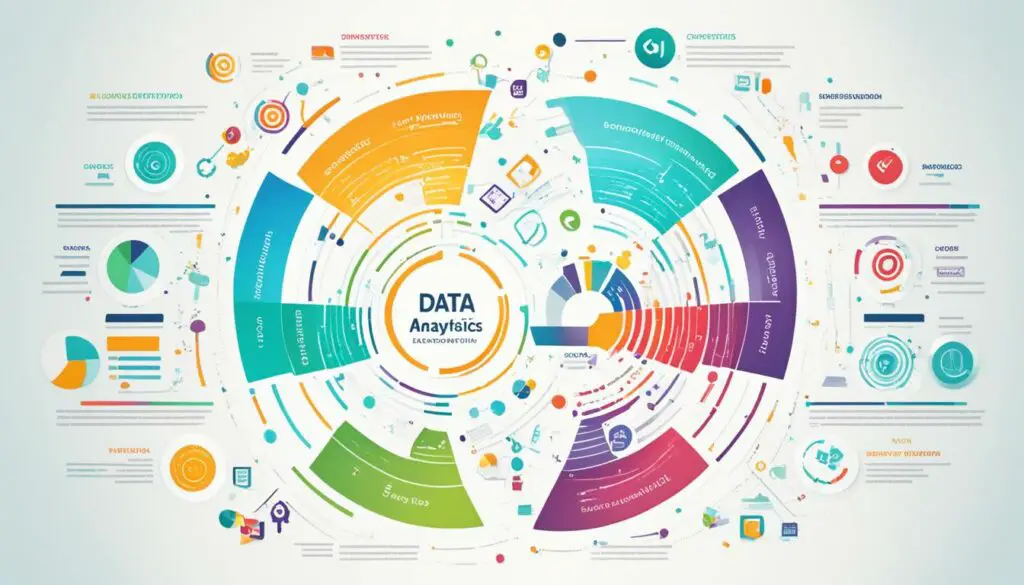Data analytics and marketing analytics are two distinct disciplines that play crucial roles in leveraging data for informed decision-making, albeit with specific focuses. Data analytics encompasses a broader scope of insights applicable across various business functions, while marketing analytics specializes in optimizing marketing strategies and customer engagement. Both types of analytics rely on data interpretation to inform decision-making and employ statistical techniques, data visualization, and machine learning to extract insights.
Key Takeaways:
- Data analytics encompasses a broader scope of insights applicable across various business functions.
- Marketing analytics specializes in optimizing marketing strategies and customer engagement.
- Both types of analytics rely on data interpretation to inform decision-making.
- Data analytics and marketing analytics employ statistical techniques, data visualization, and machine learning to extract insights.
- Understanding the differences between data analytics and marketing analytics is crucial for leveraging data effectively in business.
What is Data Analytics?
Data analytics is a process of examining and interpreting large volumes of data to extract meaningful insights and patterns. By applying statistical analysis, data mining, and machine learning techniques, data analytics uncovers valuable information that can drive decision-making and enhance business performance. Across various domains, data analytics plays a crucial role in understanding customer behavior, identifying market trends, optimizing operational efficiency, and improving financial aspects.
One of the key objectives of data analytics is to transform raw data into actionable knowledge. By analyzing data through different lenses, businesses can gain insights that inform strategic decision-making and drive operational efficiency. Data analytics enables organizations to make data-driven insights for informed decision-making, uncover patterns, trends, and correlations that may not be apparent at first glance.
Data visualization is an essential aspect of data analytics, as it allows individuals to comprehend complex data sets more easily. Visual representation of data through charts, graphs, and dashboards helps in understanding the results of statistical analysis and identifying patterns visually. Data analytics also utilizes machine learning algorithms to discover hidden insights and make accurate predictions based on historical data.
Advantages of Data Analytics:
- Provides insights for decision-making: Data analytics uncovers valuable information that helps businesses make informed decisions and develop effective strategies.
- Enhances operational efficiency: By analyzing vast amounts of data, organizations can identify areas for improvement and optimize their processes for increased efficiency.
- Improves business performance: Data-driven insights enable organizations to make data-backed decisions that drive overall business performance and success.
- Identifies patterns, trends, and correlations: Data analytics helps in recognizing patterns and trends in data, enabling businesses to identify correlations and make accurate predictions.
Overall, data analytics plays a critical role in transforming data into actionable insights that drive business growth and operational excellence.
| Data Analytics Techniques | Description |
|---|---|
| Statistical Analysis | Examines data using statistical methods to uncover patterns and relationships. |
| Data Mining | Extracts valuable information from large data sets through automated methods. |
| Data Visualization | Represents data visually through graphs, charts, and dashboards for easy comprehension. |
| Machine Learning | Uses algorithms to identify patterns, make predictions, and gain insights from data. |
Strategies in Data Analysis
Data analysis strategies encompass a range of approaches that enable us to uncover meaningful patterns and draw valid conclusions from data. By employing various techniques, data analysts can extract valuable insights that inform decision-making and drive business growth. Let’s explore some of the key strategies used in data analysis:
1. Prescriptive Analysis
Prescriptive analysis goes beyond forecasting future outcomes and aims to recommend the best course of action. By utilizing advanced algorithms and machine learning, prescriptive analysis can predict the impact of different decisions and guide organizations towards optimal solutions.
2. Diagnostic Analysis
Diagnostic analysis focuses on identifying cause-and-effect linkages within datasets. It helps uncover the root causes of observed patterns or trends, enabling businesses to address underlying issues and make informed decisions based on a deeper understanding of the data.
3. Inferential Analysis
Inferential analysis involves drawing conclusions about a larger population based on a sample of data. This strategy utilizes statistical techniques to make inferences and generalizations, providing insights that extend beyond the collected data.
4. Descriptive Analysis
Descriptive analysis aims to present relevant parts of a dataset using statistical measures. It involves summarizing data and identifying key trends, patterns, and relationships. By visualizing data through charts and graphs, descriptive analysis helps stakeholders gain a comprehensive understanding of the dataset.
5. Exploratory Data Analysis
Exploratory data analysis involves delving into the data to uncover hidden patterns, relationships, and outliers. It helps analysts gain preliminary insights and identify areas for further investigation. This strategy often serves as a starting point in the data analysis process, guiding subsequent analytical approaches.
6. Predictive Analysis
Predictive analysis utilizes historical data to make predictions about future events or trends. By identifying patterns and relationships, predictive analysis helps businesses anticipate customer behavior, market trends, and other important factors, enabling proactive decision-making.
Through the use of these data analysis strategies, businesses can extract valuable insights, make data-driven decisions, and gain a competitive edge in today’s data-rich landscape.
Predictive Analysis Use Case: Sales Forecasting
| Month | Actual Sales ($) | Predicted Sales ($) |
|---|---|---|
| January | 10,000 | 11,500 |
| February | 12,000 | 12,500 |
| March | 9,500 | 9,700 |
| April | 11,200 | 10,800 |
| May | 10,800 | 11,000 |
In this example, predictive analysis is used to forecast sales for the upcoming months. By analyzing historical sales data, a predictive model generates predicted sales figures. These figures can guide resource allocation, inventory management, and overall sales strategy, enabling businesses to optimize performance.
What is Marketing Analytics?
Marketing analytics is a crucial component of contemporary marketing strategies. By utilizing data analysis techniques and tools, businesses can gain valuable insights into their marketing campaigns, customer behavior, and market trends. By interpreting and analyzing data related to various marketing efforts, including website traffic, social media engagement, conversion rates, and customer demographics, businesses can make informed decisions to optimize their marketing activities and improve their overall marketing performance.
Marketing analytics allows businesses to understand their target audience better and allocate resources effectively. By studying customer behavior and interpreting market trends, businesses can develop personalized messaging and engage with customers in a more meaningful way. This data-driven approach enables businesses to make informed decisions that lead to improved marketing performance and better customer engagement.
With the help of marketing analytics, businesses can optimize their marketing campaigns by identifying the most effective channels, refining their messaging, and targeting the right audience at the right time. By analyzing data, businesses obtain valuable insights into customer preferences, allowing them to tailor their marketing strategies to meet those preferences and drive better results. Moreover, marketing analytics enables businesses to assess the ROI of their marketing initiatives, measure the success of their campaigns, and make strategic adjustments for continuous improvement.
Benefits of Marketing Analytics:
- Data-driven Decision-making: Marketing analytics empowers businesses to make informed decisions based on meaningful data insights.
- Optimization of Marketing Strategies: By analyzing data, businesses can identify areas for improvement and optimize their marketing efforts accordingly.
- Better Resource Allocation: Marketing analytics helps businesses allocate their resources more effectively by identifying high-performing channels and customer segments.
- Improved Customer Engagement: With a deeper understanding of customer behavior, businesses can engage with customers in a more targeted and personalized manner.
Components of Marketing Analytics
Marketing analytics comprises several key components that enable businesses to derive actionable insights, optimize strategies, and enhance customer engagement. By leveraging these components, companies can make data-driven decisions to drive growth and maximize their marketing efforts.
1. Return on Investment (ROI) Measurement
Measuring the return on investment is a critical component of marketing analytics. It involves analyzing the effectiveness and profitability of marketing campaigns and initiatives. By calculating ROI, businesses can determine the value generated from their marketing investments and make informed decisions to allocate resources more efficiently.
2. Analysis of Market Trends
Analyzing market trends helps businesses stay ahead of the competition. By monitoring industry trends and consumer behavior, companies can identify emerging opportunities, adapt their strategies, and tailor their marketing efforts to meet customer demands. This component of marketing analytics ensures that businesses stay relevant in a dynamic market.
3. Customer Segmentation
Segmenting customers based on demographics, interests, and other relevant characteristics allows businesses to understand their target audience better. By dividing customers into distinct groups, marketing analytics enables companies to deliver personalized messaging, create targeted marketing campaigns, and improve customer satisfaction and engagement.
4. Marketing Database Management
Effective marketing analytics relies on robust data management systems. Marketing databases serve as a centralized repository where businesses can store, organize, and analyze customer, campaign, and performance data. These databases enable businesses to gain a comprehensive view of their marketing efforts and make data-driven decisions.
5. Understanding Customer Perception
Understanding customer perception is crucial for successful marketing. By analyzing customer sentiment, feedback, and surveys, businesses can gauge customer satisfaction, identify areas for improvement, and adapt their marketing strategies accordingly. Marketing analytics allows companies to gain insights into customer perceptions and align their messaging and branding accordingly.
6. Sales Data Analysis
Analyzing sales data provides valuable insights into customer behavior, product performance, and revenue generation. By examining sales data, businesses can identify patterns, trends, and opportunities to optimize their marketing campaigns, improve sales performance, and drive growth.
7. Evaluation of Marketing Initiatives
Evaluating marketing initiatives is essential to assess their effectiveness and impact on business goals. By conducting thorough analysis, businesses can determine which marketing strategies and campaigns yield the highest returns and allocate resources accordingly. Marketing analytics helps companies identify successful initiatives and refine their marketing approaches.
8. Competitor Analysis
Competitor analysis plays a crucial role in marketing analytics. By monitoring competitors’ strategies, campaigns, and market positioning, businesses can identify their strengths and weaknesses, benchmark their own performance, and gain a competitive edge. This component of marketing analytics empowers businesses to make informed decisions and differentiate themselves in the market.
9. Time Series Analytics
Time series analytics involves analyzing data over time to identify trends, patterns, and seasonality. By examining historical data, businesses can forecast future trends, optimize marketing campaigns, and make data-driven decisions. Time series analytics helps companies understand the dynamics of the market and plan their marketing strategies accordingly.
10. Product Assessment
Assessing product performance in the market is an integral part of marketing analytics. By analyzing customer feedback, sales data, and market trends, businesses can evaluate the success of their products and make informed decisions regarding product development, pricing, and positioning. This component helps companies understand customers’ perception of their products and take necessary actions to improve their market position.
| Component | Description |
|---|---|
| Return on Investment (ROI) Measurement | Measuring the effectiveness and profitability of marketing campaigns and initiatives. |
| Analysis of Market Trends | Monitoring industry trends and consumer behavior to identify opportunities and adapt strategies. |
| Customer Segmentation | Dividing customers into distinct groups based on demographics and interests for personalized marketing. |
| Marketing Database Management | Storing, organizing, and analyzing customer, campaign, and performance data for informed decision-making. |
| Understanding Customer Perception | Analyzing customer sentiment, feedback, and surveys to gauge satisfaction and adapt marketing strategies. |
| Sales Data Analysis | Examining sales data to identify patterns, trends, and opportunities for campaign optimization. |
| Evaluation of Marketing Initiatives | Assessing the effectiveness of marketing initiatives to allocate resources and refine strategies. |
| Competitor Analysis | Monitoring competitors’ strategies and positioning to gain a competitive edge in the market. |
| Time Series Analytics | Analyzing data over time to identify trends and plan marketing strategies accordingly. |
| Product Assessment | Evaluating product performance and customer perception for strategic decision-making. |
Differences Between Data Analytics and Marketing Analytics
While data analytics encompasses a broader spectrum of metrics applicable across the organization, marketing analytics focuses specifically on marketing efforts and targets marketing professionals and decision-makers. Data analytics aims to support informed decision-making across diverse organizational domains, while marketing analytics focuses on measuring marketing-specific metrics and optimizing marketing strategies. Insights derived from data analytics serve a broad audience within an organization, whereas marketing analytics serves the specific needs of marketing professionals.
| Data Analytics | Marketing Analytics |
|---|---|
| Encompasses a broader spectrum of metrics | Focuses specifically on marketing metrics |
| Aims to support decision-making across organizational domains | Optimizes marketing strategies and targets marketing professionals |
| Provides insights for a broad audience within the organization | Serves the specific needs of marketing professionals |
Understanding the distinctions between data analytics and marketing analytics is essential for organizations to leverage data-driven decision-making effectively. While data analytics plays a vital role across organizational domains, marketing analytics focuses on optimizing marketing efforts and catering to the needs of marketing professionals. By harnessing the power of both disciplines, businesses can make informed decisions, measure marketing-specific metrics, and drive a broader organizational impact.
Career Opportunities in Data Analytics and Marketing Analytics
Both data analytics and marketing analytics offer a wide range of exciting career opportunities for professionals with a passion for leveraging data to drive business success. Let’s explore some of the key roles in each field and how they contribute to organizational growth.
Data Analytics Careers
In the field of data analytics, professionals play a pivotal role in analyzing and interpreting data across different domains to extract meaningful insights. Some of the career opportunities in data analytics include:
- Business Analysts: These professionals analyze data from various business functions to identify trends, patterns, and opportunities for improvement. They provide insights that support strategic decision-making and help organizations drive operational efficiency.
- Data Scientists: Data scientists utilize statistical models and machine learning algorithms to analyze complex data sets and gain actionable insights. They are skilled in programming languages and data visualization tools, enabling them to extract valuable information from data.
- Data Engineers: Data engineers focus on developing and maintaining data infrastructure, ensuring data quality, and enabling efficient data processing. They work closely with other data professionals to ensure the availability and accessibility of clean and reliable data.
Marketing Analytics Careers
In the realm of marketing analytics, professionals specialize in analyzing marketing data to optimize strategies, enhance customer engagement, and drive business growth. Here are some of the career opportunities in marketing analytics:
- Marketing Analysts: Marketing analysts are responsible for analyzing marketing campaigns, customer behavior, and market trends. They use data interpretation techniques to provide insights that guide marketing strategies, target the right audience, and maximize return on investment (ROI).
- CMO (Chief Marketing Officer): The CMO is a senior executive who oversees the marketing department and ensures that marketing initiatives align with the organization’s goals. They rely on marketing data and analytics to make strategic decisions, allocate resources effectively, and drive overall marketing performance.
- Marketing Director: Marketing directors are key leaders who develop and execute marketing strategies. They leverage data analytics to measure marketing effectiveness, track campaign performance, and refine messaging to enhance the brand’s visibility and market position.
- Head of Analytics: This role focuses on leading and managing the analytics function within a marketing department. They oversee data collection, analysis, and interpretation, driving data-driven decision-making and ensuring the use of analytics tools and technologies to optimize marketing efforts.
- CRO (Conversion Rate Optimization) Specialists: CRO specialists analyze website and digital marketing data to optimize conversions and maximize the impact of marketing initiatives. They utilize data-based insights to improve user experience, enhance conversion funnels, and generate business growth.
- Head of Business Intelligence: The head of business intelligence is responsible for providing strategic insights based on data analytics to support decision-making across the organization. They contribute to evaluating market trends, understanding customer preferences, and driving business growth through data-driven strategies.
Career Opportunities in Data Analytics and Marketing Analytics
| Data Analytics | Marketing Analytics |
|---|---|
| Business Analysts | Marketing Analysts |
| Data Scientists | CMO (Chief Marketing Officer) |
| Data Engineers | Marketing Director |
| Head of Analytics | |
| CRO (Conversion Rate Optimization) Specialists | |
| Head of Business Intelligence |
These are just a few examples of the diverse career paths available in the fields of data analytics and marketing analytics. As businesses continue to recognize the value of data in driving decision-making and performance, professionals in these roles will continue to play a critical role in shaping the future of organizations.

Importance of Marketing Analytics for Business
Marketing analytics plays a crucial role in driving business success by leveraging data to make informed decisions and optimize marketing strategies. With the ability to understand and analyze customer behavior and market trends, marketing analytics enables businesses to achieve various key benefits, including:
- Data-driven decision-making: By harnessing the power of marketing analytics, businesses gain access to valuable insights that drive informed decision-making. These insights allow marketers to tailor their strategies and tactics based on real data, ensuring that every marketing decision is backed by evidence and analysis.
- Enhanced customer understanding: Marketing analytics provides a deeper understanding of customer behavior, preferences, and needs. By analyzing customer data, businesses can gain insights into their target audience’s demographics, buying patterns, and engagement with marketing initiatives. This understanding enables businesses to create more personalized and targeted marketing campaigns that resonate with their customers.
- Optimized marketing campaigns: With marketing analytics, businesses can optimize their marketing campaigns to maximize effectiveness and ROI. By analyzing marketing data and performance metrics, marketers can identify which strategies are performing well, which ones need improvement, and where resources should be allocated. This optimization can lead to higher conversion rates, increased customer engagement, and ultimately, better campaign results.
- Maximized ROI: Marketing analytics allows businesses to measure and maximize their return on investment (ROI) by evaluating the performance of marketing initiatives. By analyzing data on campaign costs and their impact on sales, customer acquisition, and other key metrics, businesses can identify the most effective marketing channels and campaigns that generate the highest ROI.
- Forecasting and trend analysis: Marketing analytics helps businesses to predict future trends and anticipate changes in customer behavior. By analyzing historical data and market trends, businesses can develop forecasts and predictive models that inform their strategic planning and marketing efforts. This proactive approach enables businesses to stay ahead of the competition and adapt their strategies accordingly.
- Integrated data: Marketing analytics integrates data from various sources and platforms, providing a holistic view of marketing performance. By consolidating data from different channels such as websites, social media, email marketing, and customer databases, businesses can gain comprehensive insights into their marketing efforts and make data-driven decisions based on a complete picture.
- Improved performance: Ultimately, marketing analytics drives improved marketing performance by enabling businesses to measure, analyze, and optimize their marketing efforts. With the ability to track key performance indicators, monitor campaign results, and identify areas for improvement, businesses can continuously enhance their marketing strategies, customer engagement, and overall business performance.
Marketing analytics truly empowers businesses to leverage data in a way that goes beyond intuition and guesswork. By harnessing the power of data-driven decision-making, customer understanding, optimized marketing campaigns, ROI maximization, forecasting and trend analysis, integrated data, and improved performance, businesses can thrive in today’s competitive marketing landscape.
Tools and Methods in Marketing Analytics
In marketing analytics, various tools and methods are used to analyze and interpret data. These tools include:
Data Aggregation
Data aggregation tools are utilized to summarize and consolidate large volumes of data from multiple sources. These tools enable marketers to gain a holistic view of their marketing efforts and understand trends and patterns.
Data Mining
Data mining tools are employed to explore vast datasets and extract valuable insights and patterns. By applying statistical algorithms and machine learning techniques, marketers can uncover hidden information and make data-driven decisions.
Data Visualization
Data visualization tools help marketers represent complex data sets graphically. Through interactive charts, graphs, and visualizations, marketers can easily identify trends, correlations, and outliers, enabling better communication and understanding of the data.
Forecasting
Forecasting methods assist marketers in predicting future trends and outcomes. By analyzing historical data and applying statistical models, marketers can make informed decisions on budget allocation, resource planning, and campaign strategies.
Simulation
Simulation techniques allow marketers to test different scenarios and strategies before implementing them. By simulating various marketing initiatives, marketers can assess potential outcomes, optimize their campaigns, and minimize risks.
Statistical Analysis
Statistical analysis is a fundamental method used in marketing analytics to examine patterns and relationships within data. By applying statistical techniques such as regression analysis, hypothesis testing, and correlation analysis, marketers can gain deeper insights into customer behavior, performance metrics, and market trends.
Conclusion
Data analytics and marketing analytics are two essential disciplines that businesses must leverage to inform decision-making and optimize overall performance. While data analytics focuses on extracting insights from various domains, marketing analytics specializes in optimizing marketing strategies and customer engagement. Both types of analytics provide valuable insights that drive data-driven decision-making and enhance business strategies.
By understanding the distinctions and benefits of data analytics and marketing analytics, businesses can effectively leverage data to improve their marketing strategies and achieve better results. Marketing analytics enables businesses to make informed decisions based on customer behaviors, market trends, and other relevant data points. These insights help in optimizing marketing campaigns, allocating resources efficiently, and refining messaging to enhance customer engagement and maximize ROI.
Furthermore, data analytics plays a crucial role in improving overall business performance. By analyzing data across various domains, businesses can gain valuable insights that guide strategic decision-making, improve operational efficiency, and identify trends and patterns that drive future success. Leveraging data for decision-making is vital in today’s data-driven business landscape, and both data analytics and marketing analytics are powerful tools in this process.
In conclusion, businesses should recognize the importance of marketing analytics and data analytics, as well as the unique value they bring to decision-making and optimizing marketing strategies. By effectively implementing these disciplines and leveraging data, businesses can improve their overall performance and achieve their goals in an increasingly competitive market.
FAQ
What is the difference between data analytics and marketing analytics?
Data analytics encompasses a broader scope of insights applicable across various business functions, while marketing analytics specializes in optimizing marketing strategies and customer engagement.
What is data analytics?
Data analytics involves examining and interpreting large data sets to extract meaningful insights and patterns. It employs statistical analysis, data mining, and machine learning techniques to uncover valuable information that can guide decision-making and business strategies.
What are the strategies used in data analysis?
Data analysis strategies include prescriptive analysis, diagnostic analysis, inferential analysis, descriptive analysis, exploratory data analysis, and predictive analysis.
What is marketing analytics?
Marketing analytics uses data analysis techniques and tools to gain insights into marketing campaigns, strategies, and customer behavior. It involves collecting, measuring, and analyzing data related to marketing efforts such as website traffic, social media engagement, conversion rates, and customer demographics.
What are the components of marketing analytics?
The components of marketing analytics include measuring Return on Investment (ROI), analyzing market trends, segmenting customers based on demographics and interests, using marketing databases for data management, understanding customer perception, analyzing sales data, evaluating marketing initiatives’ efficiency, conducting competitor analysis, using time series analytics to analyze trends, and assessing product performance in the market.
What are the differences between data analytics and marketing analytics?
Data analytics aims to support informed decision-making across diverse organizational domains, while marketing analytics focuses on measuring marketing-specific metrics and optimizing marketing strategies. Insights derived from data analytics serve a broad audience within an organization, whereas marketing analytics serves the specific needs of marketing professionals.
What are the career opportunities in data analytics and marketing analytics?
Career opportunities in data analytics include business analysts who analyze data across different domains and marketing analysts who focus on analyzing marketing data. Marketing analytics careers include roles like CMO, Marketing Director, Head of Analytics, CRO, and Head of Business Intelligence.
Why is marketing analytics important for business?
Marketing analytics enables data-driven decision-making, enhances customer understanding, optimizes marketing campaigns, maximizes ROI, enables forecasting and trend analysis, integrates data across platforms, and improves overall marketing performance.
What tools and methods are used in marketing analytics?
Marketing analytics utilizes various tools such as data aggregation tools, data mining tools, data visualization tools, forecasting methods, simulation techniques, and statistical analysis to analyze and interpret data.
What is the importance of data analytics and marketing analytics?
Data analytics and marketing analytics are essential disciplines for leveraging data to inform decision-making and optimize business performance. They provide valuable insights that drive data-driven decision-making and improve overall business strategies.







